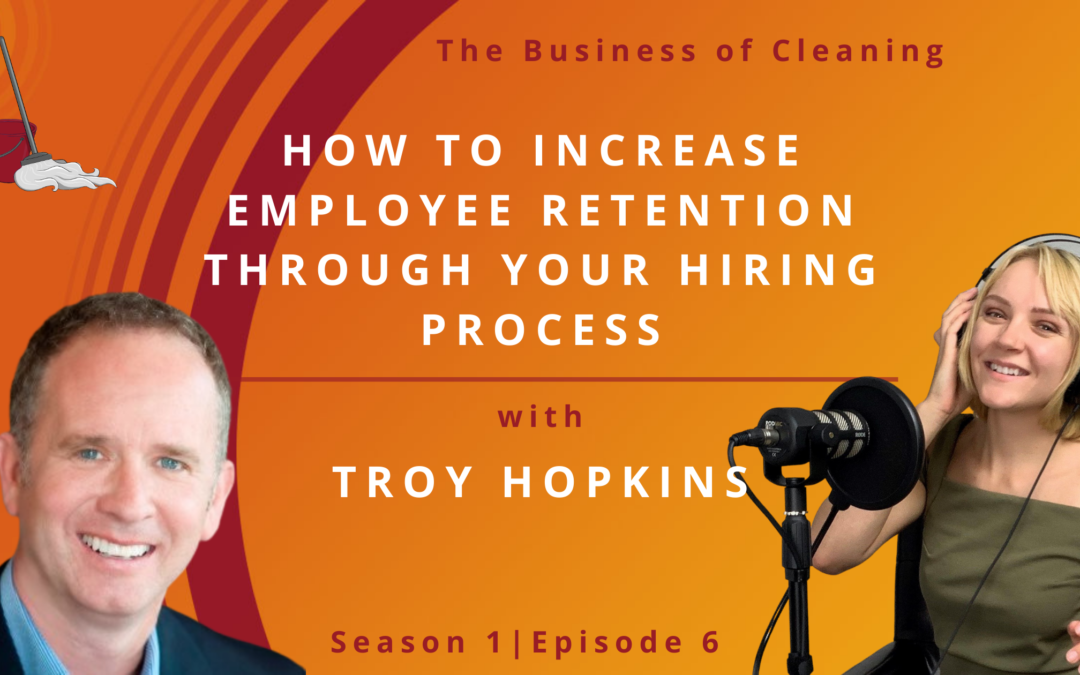Increasing employee retention is the keyword in recruitment and hiring, but what can companies actually do to improve their process and keep good employees around longer?
Click Here To Subscribe On Your Favorite Platform!
About This Guest:

Troy Hopkins
Area Developer & Coach - Office Pride
Troy Hopkins is an Area Developer and Coach for Office Pride Commercial Cleaning Services working with around 27 owners in Alabama, Tennessee, and in the Carolinas. Troy makes a point to help drive success in the Commercial Cleaning Industry.
He has even released a book called Making Cents of a Dirty Business, where he dives into the top seven challenges faced in the industry after conducting his own research and then he offers you step-by-step solutions.
In this episode of The Business of Cleaning, Troy talks about how specifically to increase employee retention by improving your hiring process. The truth? It’s cheaper to hire right first and keep the best for longer.

Podcast Transcription
Halie Morris 0:00
Hello everyone and welcome to the Business of Cleaning podcast. I am Halie Morris your podcast coordinator and host. Today with me we are very fortunate to have Troy Hopkins. Troy’s from Office Pride and he’s going to be talking to us about employee retention through our hiring and why it is so vital that we get on top of that. So, Troy if you would like to tell us more about yourself and we’ll start there.
Troy Hopkins 0:55
Great! Thanks, Halie. So, I’m with Office Pride. I’m actually a Coach referred to as an Area Developer for Office Pride. I have around 27 owners in Alabama, Tennessee, and in the Carolinas that we coach and that I try to do my best to make successful.
I think the biggest challenge that you and I both talked about is employee retention. We’re really staffing companies that clean if you think about it. So that’s what we’ll talk about. Hopefully, people that listen to this podcast could take just a few bullet points that maybe help their hiring process.
Halie 1:39
Obviously this is especially true right now. It’s a really large issue because we have a revolving door or it’s at least frequently seen that we have a revolving door of people coming in and leaving.
Maybe some people are aware and some are not, but it’s a huge cost to the company and it can be morally taxing for everybody involved. What would you say is probably one of the biggest causes of that revolving door?
Troy 2:08
Great question. On average you’ll see turnover would be as high as 400% in some companies, which is a disaster. I think, personally, that employee turnover retention is sometimes self-inflicted by the owner. Because in this industry, sometimes we want to just think that employees can just be replaced. I hope they can last for two weeks and I’ll get another employee, or they help them work on a Friday night and we don’t pour into them. We don’t have a culture.
I’m really tired of hearing that “we can’t hire employees. There are no employees out there.” We need to step back and say “we can do this,” put a system in place and appreciate these employees. That’s what I want to talk about.
My goal really for this podcast episode is for people to understand that you got to have a good first impression. The first impression is everything. Then the second thing is, the more time you spend in the hiring process, the higher your profits will be and it’s less stress. A lot of people think I do a quick hire, get somebody clean, but if they’ll take their time-and I’ll kind of show you how to do a six-step hiring process. If you walk through every step, you’ll have less stress, higher retention, and more profits. So you want me to just jump right into that?
Halie 3:30
Yeah, let’s go for it!
Troy 3:31
People have to realize what poor performers actually bring to the table. They have fewer ideas. They lose sales volume because they perform poorly, so you lose customers. They really send a message to your customers about your company’s weakness because they let you in.
The biggest thing for me, Halie, is if they’re working for me, and they’re a bad performer, that means they can’t go work for my competition and that’s what I wish they would do, is take those bad energies over to my competitor. So you have to make sure you are in control of your process.
Unfortunately, we hire someone because they are the only person that can cover on a Friday night. So really that employee has got us handcuffed. That handcuff is costing us a lot of money. That’s probably got to have at least 10% of your population. So if you have 100 employees, you have to have 10% ready to go, ready to be deployed anytime.
That’s all we’ll talk about because of the outrageous cost you mentioned earlier Halie. It is its loss of customers, recruitment costs, training costs, the ramp-up curve for new employees, lost productivity. If you lose 50 employees, at least could cost you around $50,000 and people don’t put $1 of value to that.
We got to realize that one single toxic, negative employee can be the catalyst in a downward spiral of an organization. It’s like the weakest link. That’s the best you can do in your hiring process and that’s the best quality that your customers can expect.
So I think the number one thing to do is have a great first impression. That’s why when you’re in the janitorial business, I know there’s a lot of companies that work from home, but you can’t interview people at home. To me, going to McDonald’s and interviewing people might not be the best first impression. You got to have an office. You have to have a place to do orientation, welcome people, and you have to set that expectation.
We have our hiring process. We have snacks and coffee and water. We may have a video playing in the background of our employees saying great things about our company. We got to invest in that first impression. You know when you go out and give a bid to a company, you’ll give a sales slick about your company, right? What we like to do is do a sales sheet for that employee that’s interviewing in our company, because we really got to sell to the employee, not them necessarily selling us.
So I’ll make a brochure that has company information about our vacations, holidays, growth potential, promotional opportunities, different committees, and task-forces they can be on, bonus programs if you have an educational program for them. I want to show them if you come to work with Office Pride, this is what you’re going to get right. Again, that first impression.
Let me tell you about it. I’ll summarize the six steps. Then I kind of wants to go into it, Halie, unless you have some questions about those.

The first thing is you have to get the right application. That’s the number one thing and I’ll walk through that. But on day one, I usually do it on Monday, we do our pre-screening and our phone calls for these applications, right?
On day two, on a Tuesday, we do a meet and greet. The ones we want to bring in, we bring in and we call it a meet and greet, where basically they’re coming in, they’re meeting some staff members, maybe we have one of our day porters come by and talk about what they do. They fill out a questionnaire (I’ll go through that in a second).
So basically, they’re coming in and what I’ll show you in a minute is the more time the employee comes to your office, you keep weeding out those people that won’t come back the next day. So I hate to say it, but the people that are your bad performers, they want to go through the entire process, and you’re just doing this just to see who comes back. So, that meeting and great, let’s show you the numbers on that in a second.
On day three, we have a one-on-one interview. Day four is orientation, and then we present our hiring to our selected candidate. So, before I dive into each one, any questions so far on the importance of a process?
Halie 8:14
I was just going to say, I know from the HR perspective, whenever you bring up making that application process a little more difficult, they always say, well, that’s harsh to weed out the weaker links early.
Well, do you want that person, who you could have cut out of the process or the least costly stage, to actually be brought into your company, and you have to cut them out after 30, 60, or 90 days or even much later when they already come in leech the good energy or spread a bad reputation, not actually measured up to what you thought in the interview process.
Troy 8:55
That’s right, exactly. Because it costs you so much more to get rid of somebody than it does to spend the time to do it right.
So let me give you some numbers through my research I’ve done and from my experience. There’s a lot of people who do it as a quick hire process. Say you need six employees. People will interview 15 on the spot. They’ll pick the top six of the best employees. They’ll invite them to orientation. They’ll orientate the same day.
Then they’ll ask them to come to work the same night. Of that six employees, Halie, you’d be shocked, but of six only two show up that night. So you hired them that day, interviewed them, and are taking them through orientation. They never left your office right. That night of the six, only 33% show up. Of that 33% only 17% stay.
So that’s terrible. I hear so many companies that say, what if I need 10 employees? I’m going to hire at least 30 because only 10 will show up. That’s their mentality. You know what, let me just hire the best 10 to show up.
Let me walk you through the five-step process. So let’s say you need six employees. So you might get 45 applicants. From those applicants, let’s say you invite 30 people to come to the meet and greet, right? Of the 30 people, only 67% are going to show up that next day. They all said they needed a job, right? So in the meet and greet, let’s say you find 15 that you really like. You actually have 15 that got to have a job. I got to feed my kid. I’ll be there every day.
Of the 15 only 10 show up for the one-on-one interviews. The good news is my managers now only interview people that are showing up. They’re not waiting for all these vacant slots that never showed up. So again, only 67% show up for one-on-one interviews.
Now, of those 10 people, we’re going to bring seven of them that I like to orientation. The good news is about 86% now show up. Of the seven, six showed up that next day for orientation. What we’ve done is we weed some out. This is no [additional] cost. They’re coming in and going through this process.
So, now we’re in orientation and we have now six people in orientation. I want to start those six people tonight. Almost every time, 100% show up. They’ve already been through a four-step process. I’ll walk you through those which are really interesting.
Does that make sense? To me, it’s kind of shocking when you’re looking at people in the face that need a job desperately and they don’t even show up the next day. But here’s the thing is I read them not show up for the interview, then don’t show up and I got a cleaner customer, right?
Halie 12:07
That’s what I was gonna say. You’ve got your good employees, you got your so-so, so you’ve got your bad. Then you got the ones that are scheduled and last minute without even calling, they don’t even show up. Those guys probably do the most damage because suddenly you have to fill a job with no time to spare.
Troy 12:25
Exactly. So, I’ll walk you through those steps.
The first thing is the application. To me, the best applications are referrals from other good employees. That’s the first thing we do when we have a job opening is we’ll put a group message out through our electronic management systems that say we have these two spots open. If you have 100 employees, they know family and friends that will help.
Then, of course you do Indeed, Craigslist, Facebook, social media, career centers, but also, they have an application box at the outside of our office doors. Because a lot of our demographic of employees might not have good internet service or maybe they don’t have a computer available to them at all times.
So, we’ll have an application box outside the door that says to pick up the application and beside it we’ll have a locked realtor box for them to put the application in. They could get 20 or 30 applications a night and this is on top of electronic methods. You gotta really think out of the box when you get applications.
Eric Chester said it the best. I love Eric Chester. He said you’ve always got to be canvassing. The “ABC” is “always be canvassing for employees”. When you win, birds of a feather really do flock together. Good employees hang out together with other good employees. The cost of a bad hire can be up to three times their annual salary, but people don’t understand that.
So once you get those applications, now you do phone screenings. This is a simple, little interview process over the phone to make sure they answer, the cell phone works, everything’s good, and then you invite the candidates to the meet and greet. At the meeting greet, they have to have a reason for coming, right?
A lot of times if you’re a small business, it’s just you, and nobody else in your company because you’re just starting up. This is a great way for the meet and greets because you can actually bring people in and weed out the people that are not going to show up the next day to have the interview with them.
It’s really important, but for the questionnaire, they might just fill out things to make sure they show up and give them something required to do, maybe watch a video for example. The question could be how did you hear about us, what area do you want to work in? What’s your time preference and all kinds of things that you might need in the future.
I take the questionnaire there with their application which they already have or they’ve completed, and then I let them go home. Halie, I think the biggest thing is if you tell them on the spot to come in tomorrow for the interview is great. The problem is, though, I want to let them go home. I want to see if they will answer their phone again, and call them back up and say that the interview is tomorrow at 2:00 or 2:15.
I give them an exact time for it. The meet and greet was a walk-in, from 2 pm to 4 pm. So with the interview process, the biggest thing is that you as the interviewer has to convince yourself that you love the company. If a manager, that when there he or she is interviewing, is like, Yeah, can you work Friday night? I mean, the place is really tough.
If they’re negative right, then that interviewee is not going to want to join us. You have to make sure that the person interviewing has great questions, is excited about this industry. That will obviously come right over to the employees.
Once we interview them, we then on the spot- it’s almost like American Idol and you get the golden ticket. Once they get them to interview, if we like them and they should go to orientation, we will actually give them a ticket that says orientation is tomorrow at five o’clock. Please be here on time. That kind of thing.
So, they walk out feeling like “wow, I did it! I got information about the time of orientation.” They come in the next day and, as I said, 87% show up because you walked through a process. Does that make sense?
Halie 16:42
It does. I’ve gone through this process with people before. I’ve run orientations and brought people on, things like that. The meetup is a very interesting part because I don’t think I’ve seen anybody who does that. But it’s such a good point because we’d run orientations. We do the interview and we’d offer them on the spot if they were good. We’d also do the phone screen, but we just kind of skipped that meetup stage.
Then what you would see is that usually we’d have a class of anywhere from four to seven or eight people and a couple of them would fall off. AIt was always kind of a random number where you’d always count on a couple of them falling off, and the bigger the class, the more likely you are to have more people.
I was shocked. I had a class of 17 once. We were actually counting on the fact that a couple wouldn’t show up because we were a little short on onboarding computers, but we got everybody in. It worked best for everybody so we didn’t want to reschedule people because most of the class was very excited even before we interviewed them.
All 17 showed up and it was a sort of “wow” moment. Then I think we only lost one or two the second day because it was a two day orientation. You would lose more people oftentimes before the second day, too. I think only one or two ended up not being able to make the second day.
Which, if you’re paying for orientation, which you should be, you know that they’re working for you at that point. Having somebody come in for one day, make money or come in for two days, do both orientations and make money and then dip out on you once you’ve done some training and introduction, you still have to pay them for that time. So that can be costly for sure, but you gain nothing from them.

Troy 18:27
Exactly. Some people call it Discovery Day or different things when people come in. Here in this industry, if you’re out really selling, doing what you should be doing in commercial cleaning, you always need employees. So if you orientate or do Discovery Day for the new employee and let’s say, for example, seven-show up and go through.
But you only need to hire really three people. Let’s say that you got three open spots. Well, here’s the thing, those other four need to go into waiting in the queue. You should have at least 10% of your population always available. I have folders on my desk. This is “part time day,” “part time night,” “full time-”, we have different categories.
So when Sue, that works on Saturday, calls it and quits, I can pull the folder out and immediately call Tim. “Tim, I have a position for you.” It’s based on what state you’re in and different rules and laws in different states. You can actually have a Discovery Day instead of orientation and then, when you make the hire, bring them in the next day and do your I-9’s and all your important paperwork.
You could have another step in the process, but the biggest thing is people. They want to go somewhere that they feel really appreciated, that they can have promotional opportunities and they can move up to the supervisor or operations manager or quality inspector.
So, you’ve got to do things that are going to attract the employees, because they all have lives just like everybody else does. We have to show them that this is a career and don’t let pay stand in the way. Obviously nobody in this industry pays minimum wage. One person told me the other day is that I couldn’t get somebody to play dead for minimum wage. It’s just not going to happen.
You have to pay more than the industry average. You have to reward them with bonuses, quality incentives, different things to do. A couple more tips is you got to invest in that good orientation training, obviously. You’ve got to put the money upfront. If not, it will cost you a lot more in the end.
On average, the employee decides in the first few minutes of meeting you if they’ll really be there the next two weeks. So the first impression is key. You got to do that. You have to have a good employee handbook. You have to have a handbook that has all the rules, regulations, and policies in. People have to have a guide to what’s really important to them or supposed to do.
But also you have to have tracking procedures. This is where someone’s got to really have a good electronic system to manage their processes, their disciplines, recognitions, job performance, and performance reviews, You need to give the employee performance reviews. A lot of people in our industry just kind of work from a paper and pen. They just kind of write things down, but you got to have a process, because you have to track your quality and quality inspections and tie that to the employee. You can see if you’re having bad quality and three accounts, and just so happen, the same person is cleaning all three accounts.
You gotta have a tracking system for that. So you got to invest in infrastructure to do that. The biggest thing is consistency. You got to treat people fairly and consistently. Don’t take the ones you like and treat them differently than the ones you don’t like. You gotta treat everyone consistently.
A couple of things, Halie, that I found, the one way to really help retention is that after two weeks of an employee being on board, you should do a two-week survey with them. Have somebody from the office come up, not the person who interviewed them necessarily and say, “Hey, Tina, how was your first few weeks? Did you get good training? Did you get all the supplies and tools you need? Any feedback you have on our onboarding process?”
What happens is that you’ll get all kinds of really good information about something that maybe didn’t go right in your process, or better yet, they might say, “Troy, I’m glad you called because I’m getting ready to quit because I’ve got to have five more hours or I’ve got to take this other job.” In other words, you might learn information to retain those employees.
So do a two-week survey and always provide feedback. We tell people in orientation that we’ll give you constructive feedback all the time, even on a monthly basis. When we do our quality checks, we’ll let you know if you do a great job or you have some opportunities. So I think the two-week survey is a game-changer.
Also, another tip that I do is that your employees are your recruiters, If you have 100 employees, in my opinion, you have 100 recruiters out there. So we’ll make up business cards. It’ll have their name on it and it will have the address of the office and the phone number. Then it might have “Join our team.”
So we’ll give these employees, maybe key leadership supervisors, these business cards, and as they’re out having a car wash or go into Walmart, they see somebody really working hard, and really doing great customer service they’ll say listen, why don’t you come and interview with us.” Our employees, some of them have never had a chance to have a business card with their name on it tied back to your office. They’ll just pass them out to future employees.
I’ve met a company that had a 300 person staff, and they did 100 percent of all their hiring giving business cards to employees. Again they don’t have their personal information on it, or their cell phone. It just has your office information. So another good tip.
I guess that’s kind of wrapping up my thoughts on this podcast episode. You got to treat people with respect. You gotta show them the opportunities in your company. This is there for them. So I think the stigma that there’s no employees out there, they’re all bad. It just causes a mentality thing. We’re self-inflicted with this illness. That’s kind of what I’m thinking.
Halie 24:53
I would agree. I’d say to that, you get back what you put out. So if you’re putting out that these guys aren’t doing good or these guys can’t do good- I forget what that theory is called- but they’re going to feel that and they’re going to become what you think they are or they’re going to walk away before they let themselves get to that point.
So you have to believe in people before you get them in, and then you have to have that process to vet them. If they’re committed, they’re good, and they meet all your qualifications, they’ll make it through. Those are the people that you keep for years and years and years, and those are the people that are happily handing out those business cards, because “hey, I really like where I work.”
Troy 25:37
“I have my name on a card.”
Halie 25:40
Then I’d say the last thing that I always did when I was a recruiter and I interviewed people was that I would actually just be upfront and honest about some of the tedious parts of the job.
I talked to them about the kind of people that worked for us and how they interacted and things like that, and I’d tell them about the crowd that this job is popular amongst. In that particular one, it was for high school students and retirees because the nature of it was very systematic scripted, it didn’t have any free-thinking to it except for your tone and how you conveyed the message.
I would just be upfront with people during the interview process and I would say it is what it is, but it can be really fun, your coworkers make it fun. You do get breaks and the benefits here are really great. There’s easy-to-access snacks and things like that. We did an activity book for when things were boring on the phone for people. We hashed it out every single month by hand and then printed it out.
I don’t know how my coworkers are doing it in regards to how they describe the job but I found that a lot of the people I offered if they accepted at that point, tended to show up at orientation. I was also one of those that love to vet a little more, to really look for the tone and the attitude and the kind of commitment, to see what they actually want to say. Can they deal with maybe some boring moments if they get to talk to their co-workers? Can they be optimistic about their fifth call in 10 minutes?
Troy 27:24
Exactly, that’s some good tips.
Halie 27:25
It works and sometimes you have a goldmine with a person who comes in. They’re bubbly and are going to light up the office, and then they’ll be contagious. Not everybody is going to be the big bubbly personality, but you want everybody to bring something positive and influential in a good way to space.
Troy 27:45
Perfect. I appreciate you letting me be on your podcast today.
Halie 27:52
Thank you for coming on. Troy. It’s been very good to have you and I think this is a really great time to introduce this topic to the show coming into fall.
Kids are going back to school, so parents’ situations are changing and work is going to have to kind of maybe shift for them with rolling into the cooler season and everything else. I think recruitment tends to slow a little bit about this time too, or at least the number of applicants for us sometimes slows. As it gets colder people to tend to have their job locked in or not be able to search outside of a certain zone.
I’ll go ahead and finish up right here. Thank you everyone for tuning into The Business of Cleaning. I can’t wait to talk to you next week. Don’t forget to subscribe and leave a review because I love hearing from people like Troy but I also love hearing from you. Thank you!

